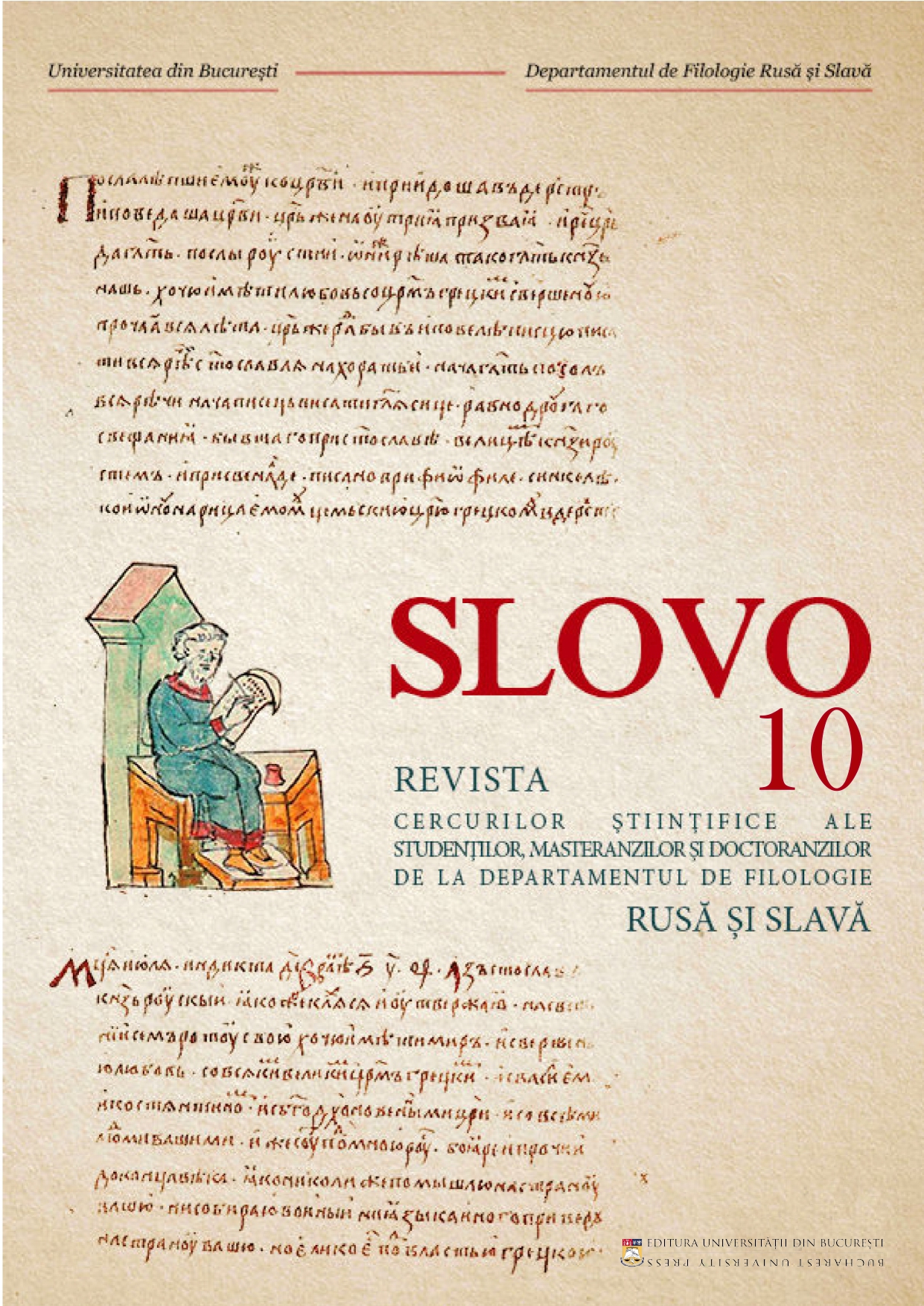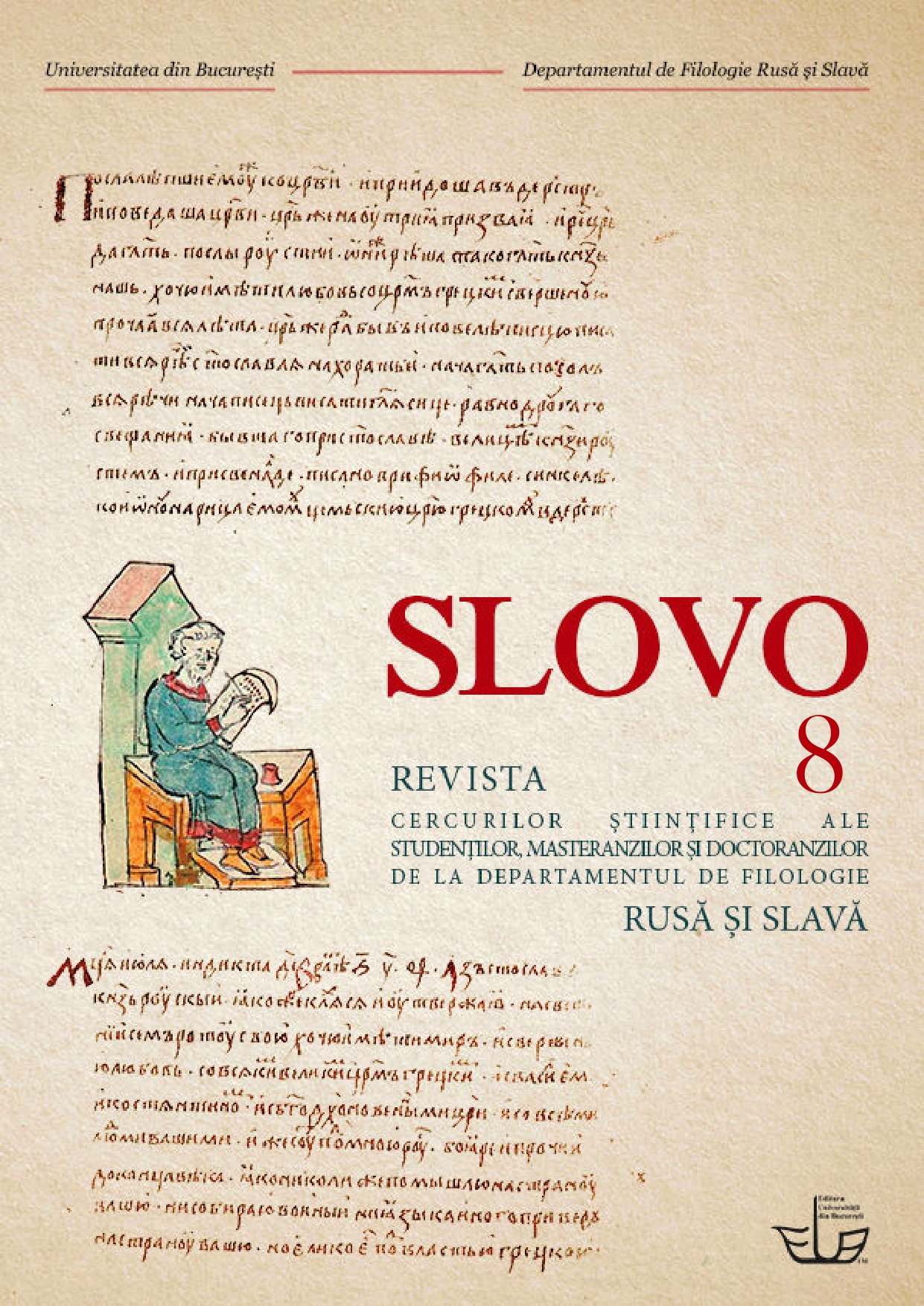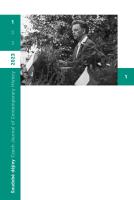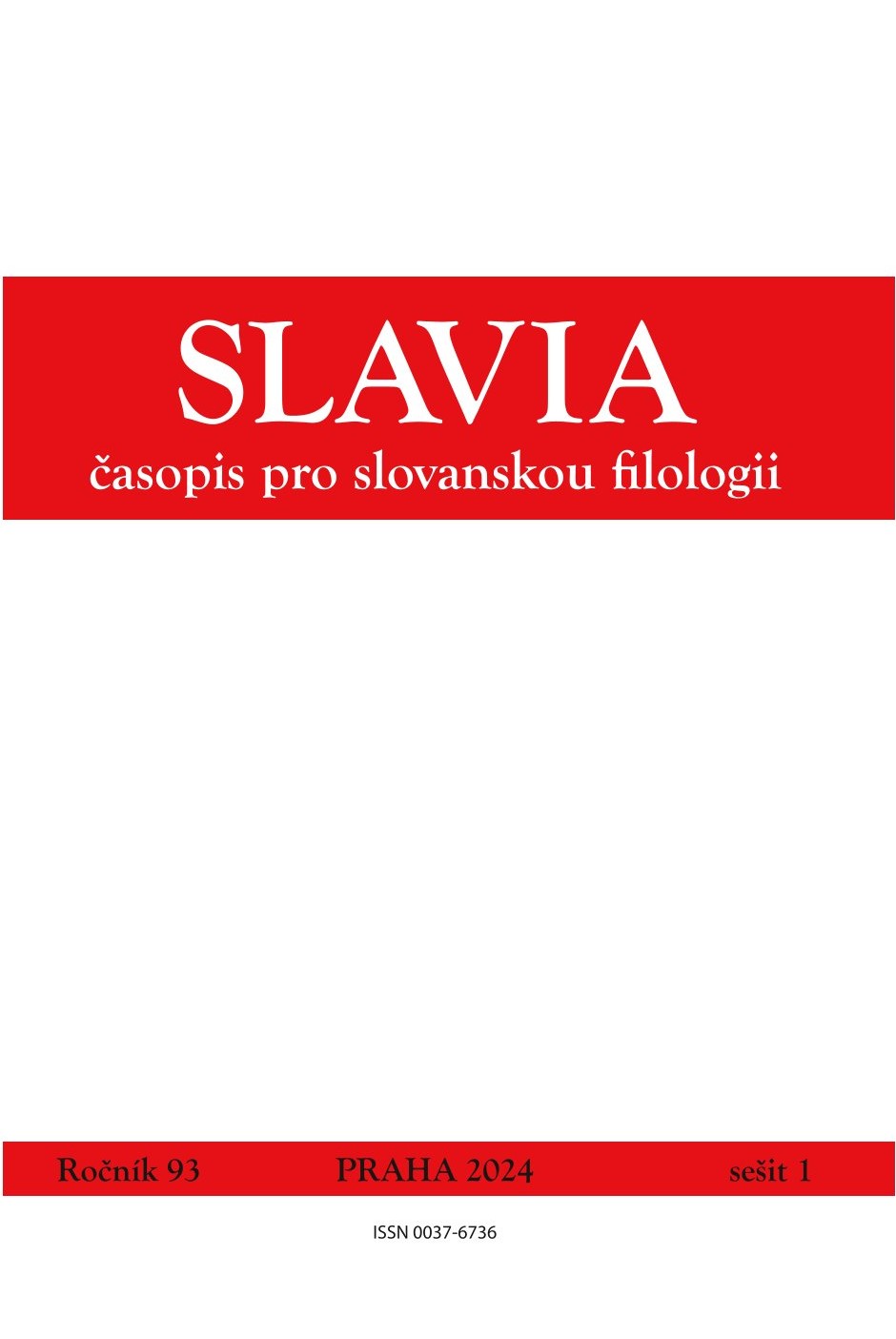
We kindly inform you that, as long as the subject affiliation of our 300.000+ articles is in progress, you might get unsufficient or no results on your third level or second level search. In this case, please broaden your search criteria.


Book-Review: Camelia Dinu (ed.), Simbolismul în literaturile slave, Pro Universitaria, București, 2020, 264 p., ISBN: 978-606-26-1233-7 (Roxana-Alexandra Alionte)
More...
Book-Review: Camelia Dinu (ed.), Simbolismul în literaturile slave, Pro Universitaria, București, 2020, 264 p., ISBN: 978-606-26-1233-7 (Mara Ionescu)
More...
The vast field of history(ies) connected with the geopolitical space of Central Europe has been written and modified, or simply deleted and reinvented several times. Populations that have been under the domination of great empires for centuries (Ottoman, German, Russian and Austrian) have borrowed from each other not only customs and traditions, but also a new mentality and a new manner of judging things. Little by little, the works of literature and various authors of many small countries were raising their own voices to create a discursive consistency. Many texts from decades ago are nowadays – besides being literary samples – also credible documents about a particular social behaviour. With making these cultural, social and political issues more visible for the public, important Central – European novelists used to create, during decades, a major cultural project about understanding the multiple factors of crisis in Europe. As a result, authors like Franz Kafka, Herman Broch, Danilo Kiš, Bruno Schulz, Robert Musil, Paul Celan, Milan Kundera were setting literary lines and terms to clarify a high range of subtle phenomena regarding politics and mentalities, dominating the space of Old Europe. Suggesting a new epic model, literary subjects directly related to the political and social collapse, a different style, and a different textual architecture, these writers were imprinting the reader’s mind with reflecting on a new epic pattern: the split of identity under the horrible effect of war and then under the political repression that followed in totalitarianism. In addition, all other sensitive issues that the Central European writers prefer to write about were passed through the filters of subjectivity and each one was revealing the experience of living in a particular area of restriction, isolation and fear. By proposing an epic product focusing on imbalances, frustrations, resentments and fragile individuals, the Central European author is revealing a powerful fiction, ready to underline the desperate need of re constructing a new and maybe a better view of a Modern European Identity – through literature and culture.
More...
The article The Linguistic Picture of Politeness in Dobšinský's legends and Erben's tales brings up the question how the meanings of the politeness concept and its context usages contribute to the broader Slovak and Czech linguistic picture of the world. To be able to answer this question we observed and interpreted various definitions of the concept we found in Slovak and Czech dictionaries and ethical manuals. With this theoretical base we have continued our observations of the concept within the literary field of legends and tales by Slovak romantic author Pavol Dobšinský and Czech romantic author Karel Jaromír Erben.
More...
Starting from the premise that the transition time is in fact, a period of identity reconstruction, when individuals are in between undefined social, political and cultural frameworks, this study proposes a comparative analysis of the liminal aspects depicted in the works of two former members of the Central-European underground from the late 80s and early 90s, the writers: Jáchym Topol and Andrzej Stasiuk. The present study brings out their similar perspectives and literary reflections regarding the post-communist period. The aspects of liminality are discussed here mainly with a focus on time and space, and on the conceptual matrix in which the writers have set up prototypes of anti-heroic characters, mappings of marginalized groups and minorities of all sorts. Besides that, through this comparison we have come to a conclusion that certifies to a certain degree, a Central-European specific found in both cases, which is the relationship with the historical past, as well as the mental attitude materialized in the ideal of refusal and mistrust towards a better future.
More...
This paper investigates the Czech contribution to the world literature over the past two centuries (1820-2020) from a global perspective. It uses computational methods to process and analyse data from the OCLC, Czech Literary Bibliography, and Czech National Library and delivers three case studies demonstrating the potential of computationally analysing Czech literature in translation. It analyses the dynamics of gender representation, target language trends, and the global diversity in terms of clustering authors according to their target language profiles. Among other things, the results identify five clusters of authors with one cluster represented globally, and the other four established in limited target language combinations.
More...
The paper provides an analysis of eschatological themes in medieval debates between body and soul related to the Kingdom of Bohemia. The oldest poem (after 1320) emphasizes the particular judgment as the dominant eschatological horizon, probably under the influence of the Processus Sathanae. The old Czech translation of Visio Philiberti (ca. 1370) seems to avoid the description of physically conceived pain of a separated soul and stresses the absence of God as the worst punishment. The third old Czech debate (end of the 14th c.) underlines the loving bond between human composites, further accentuated in a contemporary Latin prose debate between body and soul by the archbishop of Prague John of Jenstein in his Liber dialogorum.
More...
The article aims to indicate the contradiction of lightness and heaviness that permeates the culture of narcissism and tangibly affects the lives of young people, becoming problematic for future generations. Questions: Does cultural narcissism determine contemporary young people’s attitudes full of contradictions, the antinomy of lightness and heaviness? If so, how does narcissism affect the understanding of community and relationships? The meeting places and relational spaces of young people, mediated by the media, spread the virus of adoration, self-admiration and privilege; this is a direct result of cultural narcissism. I observe this and many other determinants of dissociation resulting from the influence of the culture of egoism in the self-destructive attitudes and choices constructed by young people. Self-indulgence and adoration very often lead to a sense of emptiness, little worth and loneliness. This article will defend theses on visible dissociation in selected areas of youth’s existence. I will refer to the analyses of interviews with selected students conducted within the pilot research project on “Ego Addicts”. The background for the considerations is also examples from the life of characters from the prose of Milan Kundera; inspirational, they are both unbearably light and heavy. The narcissistic lightness of being can become a direction indicator for educators in diagnosing the heaviness, i.e. low value and loneliness and other dilemmas of youth.
More...
Review of: Camelia Dinu (ed.), Simbolismul în literaturile slave, București, Pro Universitaria, 2020, 263p., ISBN 978-606-26-1233-7
More...
The book entitled "Praha, hlavní město dvacátého století: Surrealistická historie" is a Czech translation of the original English edition "Prague, Capital of the Twentieth Century: A Surrealist History" (Princeton – Oxford, Princeton University Press 2013) by British-Canadian cultural historian Derek Sayer. It deals with a number of events, phenomena and figures from the artistic and cultural history of Prague and the Bohemian lands from the late nineteenth to the second half of the twentieth century, with a special focus on the interwar period. The reviewer is primarily concerned with the author’s method. Sayer, she argues, takes inspiration from the methods of the German philosopher and sociologist Walter Benjamin (1892–1940), and in the style of montage and collage (as a “ragman of memory”, as Benjamin himself put it) freely transitions between different time periods, fields of art and culture, and the perspectives from which he examines the phenomena under study. The surrealist movement from the book’s title is only one of the topics which reveal the author’s predilection for the myth-making genius loci of “magical Prague”, in the spirit of the Italian writer and Bohemianist, Angelo Maria Ripellino (1923–1978). But Sayer does not equal Ripellino in poetic quality. In terms of the scope and diversity of the facts and events discussed, Sayer’s book is a monumental achievement, but the reviewer points to methodological problems in the handling of literary texts, a limited knowledge of Czech scholarly literature and a sensationalizing tendency. What is innovative about the book is not the point of view or the facts presented, but their arrangement, which represents a postmodern way of writing about cultural history.
More...
This paper focuses on publications by Karel Hausenblas on questions surrounding literature and literary texts. Hausenblas is one of the classics of Czech linguistic bohemistics, but he also published numerous articles of significance to the study of literature. This overview describes the main areas of Hausenblas’s literary explorations: His conception of style as a principle that integrates all levels of texts into a dynamic unit proved to be adequate to the complex structure of literary works. He analyzed the use of language in the works of various Czech writers and explored the semantic, thematic and communication structures in literature. He also dealt with the features of poetry and with the problems of literary translation. Karel Hausenblas’s legacy, combining theoretical elements with thorough analyses, still deserves interest and inspires us to follow.
More...
This study discusses the approach of Karel Hausenblas (1923–2003), an important Czech linguist and Bohemist, towards literary theory. The main objectives of the study are: 1) to outline the basic theoretical and methodological principles of Karel Hausenblas’s scholarly research; 2) to present Hausenblas’s conception and treatment of selected terms from literary theory (especially “theme”, “literary character” and “space”). The author of the study demonstrates that the theoretical assumptions and methodological principles on which Hausenblas based his stylistic research draw significantly from Czech structuralism, formulating six of his most important theoretical and methodological principles. The outline of his treatment of such literary-theory concepts as “theme”, “literary character” and “space” make it clear that Hausenblas was not looking for a fundamentally new conception, but was much more concerned about their precise definition and correlation.
More...
The literature of the so-called Eastern Turn which dominates the German migration literature of the 21st century shows common thematic features regardless of the authors’ country of origin, but also differences related to the migration background of the author in question. German authors with Czechoslovak roots often refer to Franz Kafka in their texts. This has a pragmatic function – writers from the East want to establish themselves in the (West) German market by referring to this world-famous compatriot. Allusions to Kafka reflect the peculiar reception of his texts in a country with a communist dictatorship. Moreover, the references to Kafka in Reinerová, Moníková and Wagnerová are gender-specific: they are simultaneously an emancipatory settlement with a literary tradition shaped by men.
More...
Reviews of: Max Brod: Franz Kafka. Životopis (Bibliographie) Odeon, Praha 1966. 289 pp., 50 planches Max Brod: Život plný bojů (Une vie pleine de luttes) Mladá fronta, Kapka, knihovna pro každého, Praha 1966. 316 pp.
More...
Jarmila Mařanová, artiste qui se consacre depuis longtemps à l’art graphique, s’est présentée pour la seconde fois à la synagogue Espagnole dans une exposition organisée le 8 juin 1967 par les soins du Musée juif d’Etat et comprenant un recueil de vingt trois feuilles graphiques sur le thème Franz Kafka et Prague. L’oeuvre littéraire et le personnage de Franz Kafka attirent de nombreux artistes qui tentent de reproduire l’atmosphère de l’oeuvre et les pensées du grand écrivain. Parmi ceux-ci se range Jarmila Mařanová par son cycle d’illustrations du roman „Le Procès“.
More...
The article commemorates the 90th anniversary of the birth of the physician Karel Fleischmann, who was born in 1897 and spent the end of his life in the Terezin concentration camp-ghetto. He depicted the Terezin reality in drawings, pictures and writings. A paper on Fleischmann’s Terezin productions appeared in Judaica Bohemiae, vol. XVIII/1982, No. 1. That is why the above paper only deals with his pre-war writings.
More...
Waiting is a constant in the different ages of literature, having a psychological invoice function. A first pose of the expectation entered into the archetype is that of Penelope, the queen of Ithaca. Indeed, the paradigm of waiting draws its sap, par excellence, from the tribulations of Odysseus whose wife, Penelope ennobles his existence on the other hand, Lucius the character of Apuleius tries his best to reach that desired called "prosopon" recte the full manifestation as a being human. In Franz Kafka's Metamorphosis, Gregor Samsa is the prototype of vain expectation. Human appearance is denied him forever. In the register of modern dramaturgy, Eugen Ionescu creates the premises of an expectation of invisible characters. The old man and the old woman manage through their lines to establish a climate that we would call: waiting for some specters. Gabriel Garcia Marquez surprises us with the successful atmosphere in the micro-novel: The Colonel has no one to write to. The colonel's waiting in the harbor, where the illusion boat was supposed to appear, is tragic par excellence. The following nuances of waiting will be nuanced in Samuel Beckett's Waiting for Godot where the intrusion of the absurd is total. Also the novels: The Desert of the Tartars by Dino Buzzati and Waiting for the Barbarians written by John Maxwell Coetzee advertise the same coordinate of waiting. Giovanni Drogo and the magistrate, the characters in the two books seem to "feed", paradoxically, on this substance of vain expectation.
More...
The main purpose of the article is to show the traumatic experiences (the Chernobyl tragedy, the Holocaust) from the animal perspective. To achieve this goal, two prose texts have been compared. Although the texts differ in their narrative strategies, both place an animal protagonist in the center. In the stories Lions by the Belarusian prose writer Ivan Ptasznikau and The Dog written by an Israeli writer of Polish origin, Ida Fink, the animal goes through a painful experience that is close to a human one. These texts fall within the context of the so-called posthumanistics, emphasizing the collectivity of the human and animal lives.
More...
Václav Řezáč is primarily known for his novels, but in the late 1920s and early 1930s, he made his mark with poems, short stories, and theater criticism published in magazines like Český svět, Eva, and Svět ve filmu a obrazech. His critical reviews, often signed with the initials –vč– or vč., showcased his broad cultural insight and were complemented by notes on current theatrical events. These reviews provided comprehensive evaluations of contemporary staging practices, considering dramaturgical choices, artistic direction, and the interplay of various theatrical elements. Writing his own works took Řezáč some time, and his criticism helped him clarify his artistic criteria, reflecting on societal and political events between the world wars. His theater criticism offers a significant glimpse into his aesthetic and ideological views, which have been partially documented by previous literature but not systematically. This bibliography compiles Řezáč's contributions, particularly his theater reviews, from 1928 to 1934, providing a foundation for further research in interwar literature and theater history.
More...